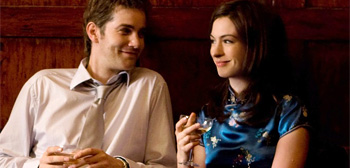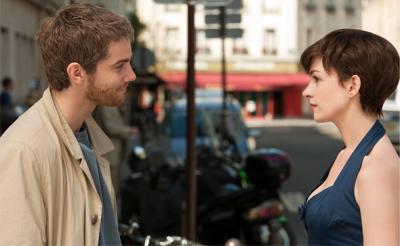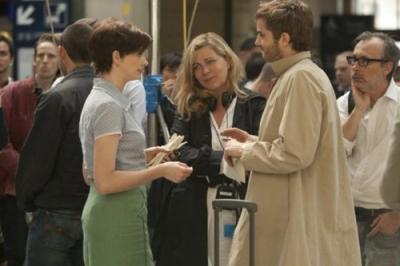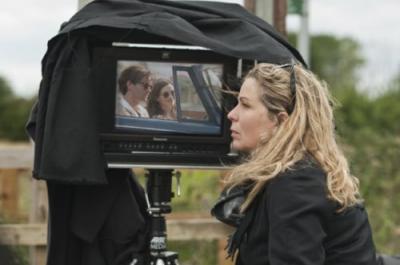By: debbie lynn elias
We are definitely on a roll this year with some high caliber book to screen adaptations. Generally, a disappointment when the literary word is translated to t he big screen, 2011 has thus far yielded a healthy crop of best sellers that are equally as wonderful on screen as on the printed page. The latest entry is from none other than Lone Scherfig. Wowing us last year with her breakout multiple Oscar nominated feature, “An Education”, this year, Scherfig steps up her game with the visually and emotionally stunning, ONE DAY.
Adapted for the screen by David Nicholls from his best-selling book of the same name, ONE DAY is the story of Emma Morley and Dexter Mayhew. Meeting for the first time on July 15, 1988, at their college graduation, ONE DAY follows their lives for the next 20 years, picking up with Emma and Dex, be they together or apart, on July 15 of each subsequent year. We follow their lives’ journeys as they search for that one thing we all seek, love. And as time passes and life unfolds, the true meaning of that fateful day in 1988 is revealed and how it set their paths in motion.
Calling on Anne Hathaway and Jim Sturgess as Emma and Dex, the performances are effortless and strong. Sturgess, in particular, goes through this great emotional and physical metamorphosis that has you riveted to the screen. Likewise, Hathaway’s emotional arc goes from the facade of self-assurance to actual joy and confidence. The transition spans their lives and is never rushed or hurried, unfolding at a realistic and comfortable pace.

ONE DAY is an absolutely amazing, amazing film. You laugh. You cry. You hope. You wish. You want, and can’t wait, to see love unfold. Always a joy, I had a chance to sit down with Lone Scherfig for an exclusive 1:1 interview and talk about her own education with directing ONE DAY. There is always a great warmth and kindness that radiates from Lone. And when she speaks about her work, it is done with humility and grace. She is candid with emotions that come from her heart with honest sincerity and reflection. And when it comes to ONE DAY, one only needs see her smile or hear her laugh to know how dear this film is to her.
You will see some Oscar nominations for this film, Lone.
LS: You think so? There are a lot of good films coming up.
But none have a story like this. This story and this film is so pure in the essence of love and it’s so comfortable that you feel the love from the film without realizing it.
LS: That’s good! That’s very uplifting. Thanks for saying that. Your first hope is just that someone will come and see it.
There’s no way that people will not come see your film.
LS: But I’ve never done it [marketing and release] and I didn’t have the festival circuit. But it’s not so important for this film because it has American actors and distribution. It’s a bit different strategy and a different way that [marketing] is being done which I haven’t tried before.
I have to ask you, because I know that with AN EDUCATION you used a Barbie doll dress to come up with one of the cocktail dresses.
LS: [laughing mischievously] Yes. Solo-in-the-Spotlight.
Do you have any Barbie inspired dresses here? I’m looking at the one white with blue flowers that Anne is wearing.
LS: Isn’t that one beautiful?
It’s so stunning and has that 50’s Barbie feel to it.
LS: No. The only costume that’s made this time is the Mexican restaurant outfit because she works there for awhile and the costume has more sizes because she gains weight while she’s working there. So, I think that was actually the only costume that was originally made for [Anne]. But Patricia Clarkson’s clothing are tailor made.
I’m sure. Patricia is so tiny and petite. And she is just so elegant, always.
LS: I know. It’s such a privilege to have met her and worked with her. I hope I can do that again. I’m sure when we last met I might have talked about how I love working with British actors because they are very craft oriented and technical and humble. But, then again, when I think about [Patricia] and Peter Sarsgaard and Anne Hathaway, who are all American method actors, that I like as well. And Anne, the way she is emotionally involved adds some warmth to the film and some sensitivity to the film that I really think suits it. She’s like a darker, more expressive Emma Morley than if you read the book, but she just has this heartbreaking quality to her that I really love.
 And remember now, her first film she did learn from the master in Julie Andrews! So that British sensibility may come in there, too.
And remember now, her first film she did learn from the master in Julie Andrews! So that British sensibility may come in there, too.
LS: [chuckling] Maybe. But also because you don’t get to dance as well as Anne does, or sing as well as she does or speak all those languages or analyze text the way she does without being very hardworking. So she has something that simmers with the British work ethic in the way she approaches things because she’s just very thorough.
That’s also what makes her a perfect Emma.
LS: It makes her a perfect actress. It’s so fantastic to work with someone who is that devoted and quality oriented. So that’s been a good thing that I’ve tried to work with someone who is a film star in the sense that I’ve not tried before. And it’s not that type of film because of course we would move around all the time. It takes place in England and France and Scotland but it doesn’t feel like a studio film and very little is shot on stage. So it’s also about getting the most out of the features of the rooms you’re in and working with the physicality of each of all those locations. That was another thing that I hope added to the life of the film. There is so much going on location-wise and color and design and cars and…

That’s something that really stands out and speaks to me. How did you approach the visuals because the color is so vital and so important to this film? Production designer Mark Tildesley has done a WOW job! I think the last film of his that had this much emotion contained within the production design was Danny Boyle’s “Sunshine”. And then you have Benoit Delhomme come in as cinematographer with beautifully realized visuals that are different from his prior works, especially, “Boy In the Striped Pajamas.” Between the cinematography and Mark’s production design, how did you go about making these decisions and putting it all together?
LS: I’ve never worked with something that had that much color. Not even in the commercials I did.
Was it a conscious decision to utilize color to this extent?

LS: Yes. It was. I wanted it to be a summer film and a bright film and that had a lot of energy. I thought it would make sense to do something that was Scandinavian, minimalist or puritan. It was much more about getting all these details to somehow work and somehow have an identity in color. Even if you see so many different worlds, that there is so much detail. Benoit, and I and Mark would talk about how each of the locations would inspire…it’s almost like 20 little films that are tied together. Like a Jackson Pollock painting where it’s a huge system of a lot of details but somehow is one organism. That was the hardest thing about [ONE DAY] – to make it full of detail without being messy.
That’s what adds so much to the genuineness and the heartfelt honesty of the film. Everything is beautifully realized visually through exacting lighting, camera shots and particularly the tonal use of color. Simply stunning. I love the early use of blues – especially with Dex. The shading and shadowing is not only telling of the uncertainty of his life, but also comforting, almost enveloping him as if in a cocoon.
LS: I hope so. It has style but it’s not stylish.
The date transition from year to year is so key. Using the July 15th tracking with some simple but catchy FX is a wonderful time line tool without being too “in your face.” The change of time has the same ease as the film. How did you decide to use the novel approach or random pop-ups in life that you chose?

LS: That’s later. We didn’t decide that until we were done filming. It’s amazing. It’s something we did in the editing. It’s like her bra strap and you hear the sound go “snap” and then “snap” comes a date. It’s in the editing. It’s not puritan. A good cut comes from the sound of a bra strap to the date coming out of a toaster. I think it suits. The writing too is very full of detail. You wanted the film where you feel that all these people who have worked and there was excess energy. Whereas in “An Education” it was much more slick precise creature. I enjoyed it [the different energy of ONE DAY] and I thank Mark for making me dare to use color because I had never done that before.
It works.
LS: You think? In film school [the films] were black and white and then little by little I’d add a little blue, a little red and then with this film it’s all awash!
It’s so comfortable to watch. It envelops you like a blanket when you’re watching it.
LS: Thank you. I’m very glad to hear that.
It is a beautiful, emotionally rich film.
Very interesting is the aging of Emma and Dex. Anne ages. But it’s always a lot easier to age women with the hair and whatnot. But Jim goes through this complete transformation and metamorphosis. It almost looks like he was actually losing and gaining weight.
LS: Yes. They both were. But also, especially when shoulder pads changed sizes. We didn’t shoot in sequence so it’s also about what they wear and about making it hopefully happen in a way that when you see it you are not distracted by it. Because there are so many hair and make-up changes. So that when you get to the end and you are back in 1988, part of the message of the film is how did all that time pass, how was it that we lived our lives, what were the decisions that we make or didn’t make…that you get that feeling, “Oh, I didn’t realize that they were so young in the beginning of the film that all that time has passed.” So, I’m hoping it works that way and that once you see them young again then you realize how big a change it was that you were watching, especially with Jim’s character. It’s a great make-up and hair job. A fantastic job.

As for the screenplay, it equals the emotion of the book, filling every emotional cavern within one. A love story in the truest and purest essence of love. You know these characters inside and out with an uncommon but easy familiarity. The screenplay and film make you “feel” without consciously making any effort to do so. Everything is so genuine, so “right”, so honest. As detailed as this story is, visually and in dialogue and storyline, was there any improvisation?
LS: This is pretty much the script. David [Nicholls] writes really good dialogue. He, himself, was an actor originally so he knows. We’ve added very little. The “Spartacus” moment is improvised. That was funny. That’s good. And sometimes when you need to because you have a child or a baby. But no, this is quite close to the script.
What was the most challenging aspect of this particular shoot?
LS: Doing all the time jumps. Films jump in time all the time. But in order to make it cinematic and light. And also the challenge of having such a major tragedy in the middle of something that is light and to make it meaningful for the audience. There’s a big tragedy in the middle of the film.
That was a real shocker.
LS: You need to see it so that it doesn’t feel unfair in a bad way. So it feels like it happens because it is meaningless and unfair, but it gives the film something and it gives the audience something that you wouldn’t have if it had had a whole traditional progression of the story.
What did you personally take away from this film?
LS: I have a daughter who’s 16. I’m glad to do something where it’s so obvious that when women are so insecure, like a lot of women are, and Emma Morley is one of them, that there are detours you didn’t need to make. It shows you what love is and what love can be and what it is that you should try and find. That the love in the film is a little more real than love in a lot of other films and not like when they find out they love each other and the film ends. That it’s not just Dexter who learns what love is. It’s also Emma. But what I personally took away from it is that I just want to work with these people again, and I want to shoot more. It was a really good process. And of course, what a privilege to shoot in Paris and Britain and Edinburgh, which I love. So the shoot itself was wonderful. And also, there’s so many different demands on your craft on this film. There’s so many different types of challenges, so that was really satisfactory to bring out the big toolbox and use everything you’ve picked up over the years and have an opportunity to really do something that is very different. Some scenes would be hand-held and dogma-like and other scenes much more classic, epic. You got to use 7 1/2 octaves not just the minimum. That I really enjoyed.
#











